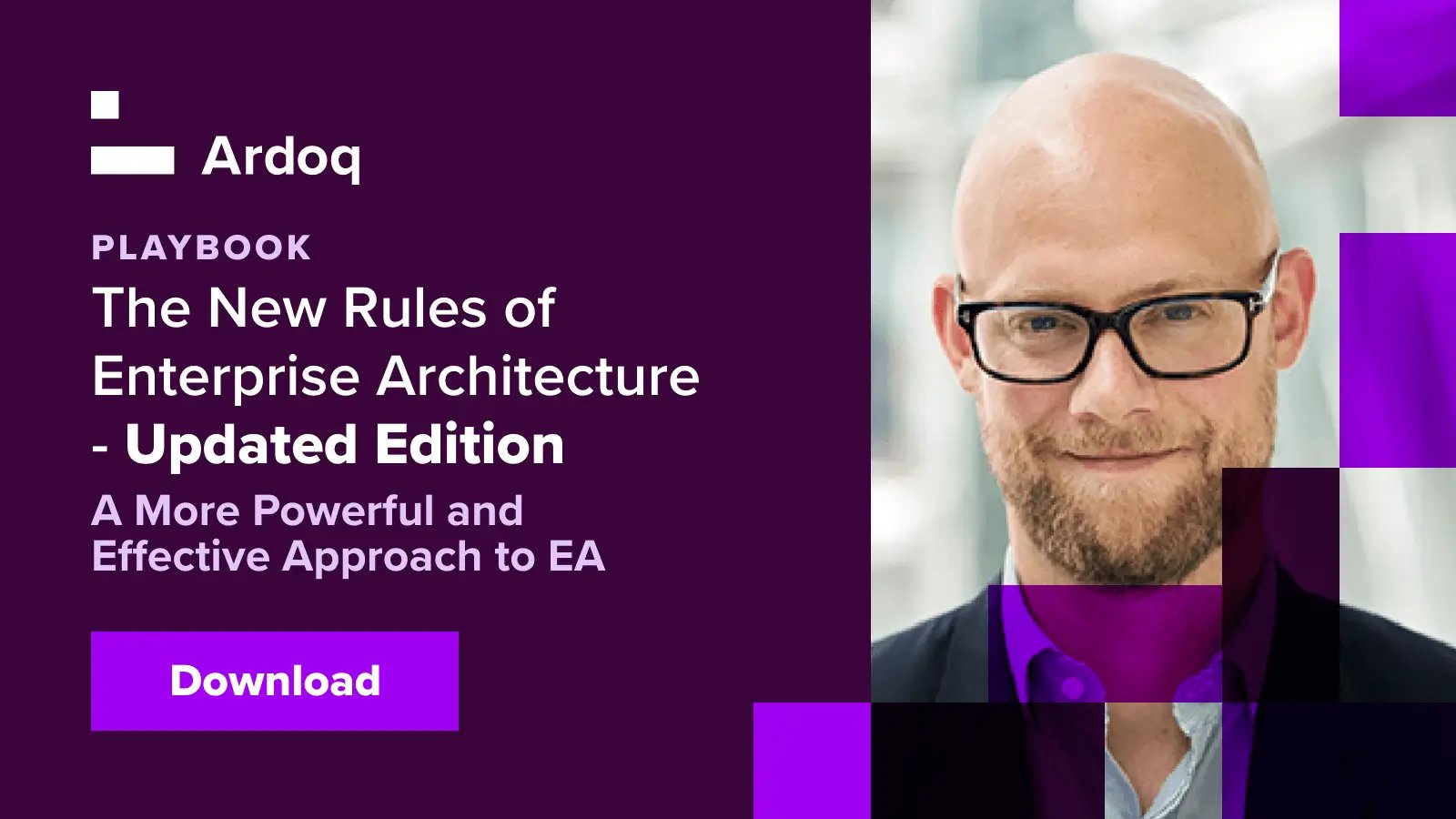As technology changes rapidly, businesses can’t risk getting left behind. But an organization can’t embark on any transformation without knowing what it wants to achieve—and what kind of infrastructure is necessary to support it.
The journey begins with Enterprise Architecture, a blueprint for an organization’s structure and operations. But what exactly is it, and how does it help a business?
In this Enterprise Architecture 101, we’ll cover Enterprise Architecture basics and how to implement them successfully.
Jump to:
- What is Enterprise Architecture?
- What Are the Four Domains of Enterprise Architecture?
- Why Enterprise Architecture is Important
- Enterprise Architecture Use Cases
- Enterprise Architecture Process Step-By-Step
- 12 Enterprise Architecture Best Practices
What is Enterprise Architecture?
It’s tricky to pin down a single Enterprise Architecture definition. It’s basically a framework that documents current IT assets and business processes to transition to a desired “future state” that supports the business’s overarching goals.
Enterprise Architecture (EA) identifies IT systems, applications, and processes and how the parts fit together. Enterprise Architects map this structure, model the business capabilities, and identify opportunities for optimization. A substantial amount of their work is governance, data collection, and data maintenance to keep the organization's “blueprint” reliable and relevant. This includes standardizing processes and reorganizing IT infrastructure to align with the goals.
Although EA was initially primarily about IT infrastructure, the evolution of Enterprise Architecture means that it also encompasses business architecture and people in the model for deeper insights into the enterprise.
What Are the Four Domains of Enterprise Architecture?
Within Enterprise Architecture, there are four primary architecture layers or domains:
-
Business Architecture: Focuses on the business strategy, governance, organization, and key business processes. It outlines how the business operates, the business processes used, and the interaction between these processes and the various business functions.
-
Application Architecture: Focuses on specific applications used in the enterprise, how they are designed, and how they interact with each other, users, and other applications.
-
Information Architecture: Deals with the structure of an organization's logical and physical data assets and data management resources. It concerns how data is collected, stored, transformed, distributed, and consumed. It also deals with data governance and policy.
-
Technology Architecture: Documents the hardware, software, and network infrastructures used in the business and how they are deployed.
Why Enterprise Architecture is Important
We’ve got a handle on the broad meaning of EA—now to find out why it matters.
New technology is evolving rapidly—and developments like AI, machine learning, and IoT are making IT systems more complex at a higher speed than ever. Digital Enterprise Management helps a company stay on top of all this new tech and where it fits into the business strategy.
EA has the potential to bridge the business and IT teams by providing a unifying language centered on capabilities and business outcomes. It clarifies how all the components of the organization work together and makes critical interdependencies visible.
Enterprise Architecture shows a business where it is and how it is doing, which helps a company understand where it wants to be and how it might get there. Plus, when an organization understands how systems work together, it can ensure IT investments are tied to those goals.
The Advantages of Enterprise Architecture
Let’s take a look at the many benefits of Enterprise Architecture:
-
If a business is undergoing a major change, such as a digital transformation or a merger, EA insights can help it to implement the project more smoothly, quickly identifying critical capabilities and resources.
-
Enterprise Architecture involves thoroughly assessing current infrastructures, allowing a business to identify gaps and inefficiencies. This highlights opportunities for innovation, improvement, and optimization.
-
EA documentation gives a clear overview of the organization’s IT assets. This information can help reduce complexity and improve system interoperability. By spotting ways to eliminate duplication and allocate resources more efficiently, a business can lower costs.
-
With data-driven Enterprise Architecture, an organization can use the data to determine which areas to focus on. A deeper understanding of business capabilities helps make faster and more informed IT investment decisions.
-
By implementing EA, a business can improve transparency and communication since the documentation helps all departments (not just IT) to understand the business model and infrastructure.
-
Insights from EA modeling can also highlight ways to reduce risk by improving information management and security and analyzing the impact of potential problems.
-
These benefits increase an organization's operational resilience and agility, helping it keep up with industry trends and manage disruptions.
Enterprise Architecture Use Cases
Enterprise Architecture has multiple use cases. For example, if a business is migrating to the cloud, it helps with planning and identifying the best strategy for the organization. But apart from IT landscapes, it can also streamline operations in the manufacturing industry and ensure compliance and data security in financial services.
EA is used in sectors as diverse as healthcare, retail, and real estate, integrating systems for efficient operations and better user experiences. Here are some digital transformation and Enterprise Architecture success stories spanning various industries and markets.
Here is a list of the many sectors where EA performs well:
-
Education
-
Healthcare
-
Manufacturing and Engineering
-
Media
-
Oil, Gas, Mining, and Farming
-
Public Sector and NGOs
-
Retail and Hospitality
-
Food and Beverages
-
Human Resources
-
Legal Services
-
Management Consulting
-
Market Research
-
Technology (Computer & Network Security)
-
IT Services and IT Consulting
-
Software Development
-
Telecommunications
-
Transportation & Logistics
There are some EA teams that would prefer to use an Enterprise Architecture framework, and there are several to choose from:
- TOGAF (The Open Group Architecture Framework) is an open-source framework that offers a common language for describing and analyzing relationships between EA elements. It provides universal concepts and guides for different situations.
- The Zachman Framework is a classification system for standardizing and defining IT architecture components. It’s a matrix of six columns and rows, where the rows define different types of stakeholders, and the columns frame their perspectives.
- Gartner doesn’t provide a framework, but it has established a set of best practices for EA, focusing on business outcomes.
- Industry-specific frameworks also exist, such as the Federal Enterprise Architecture Framework (FEAF), the Department of Defense Architecture Framework (DoDAF), and the European Space Agency Architectural Framework.
However, Ardoq is framework-agnostic and flexible enough to support different approaches. We also strongly recommend that businesses and their EA teams always model with business outcomes in mind rather than specific frameworks to ensure the process uncovers tangible value quickly.
Enterprise Architecture Process Step-By-Step
No matter which framework a business uses or if a company has none in mind, here’s how to shape an effective Enterprise Architecture strategy:
-
Define Objectives
What does the business want to achieve through EA? What is the future state it would like to get to? Goals can be anything from reducing operational costs to improving customer service. Make sure they align with overall business objectives.
-
Assess Current State
Carry out a thorough audit of IT infrastructure and systems, and inventory technology and information. Model business capabilities as needed to identify strengths and weaknesses. Which areas need to be prioritized to achieve business objectives?
-
Bring in Key Stakeholders
It’s important to shape plans collaboratively with stakeholders, such as team leaders, IT staff, and end-users, and get their input. The diverse perspectives of different teams outside IT will develop real insight into what is needed on the ground.
-
Create an Implementation Plan
The next step in Enterprise Architecture planning is to build a roadmap to show how the changes the business needs to achieve its goals will be implemented. While this is often done manually in static documentation, future state planning is faster and easier with Ardoq’s scenario modeling features.
-
Monitor and Adjust
Once the plan is in operation, a business must monitor progress and results. If it’s not working out as expected, check for problems and adjust as needed.
12 Enterprise Architecture Best Practices
Now for some top tips to highlight the true value of Enterprise Architecture:
-
Establish a program charter that outlines the project's expected benefits and how those benefits will be achieved. It should include stakeholders, timelines, and success criteria.
-
Decide how the future state should look before carrying out the current-state analysis. This minimizes the level of detail required for the current state.
-
However, a full overview of infrastructure is necessary. Most organizations begin with applications and systems but enrich this information with modeling capabilities and people if it helps provide the insight required to make better decisions.
-
Use relevant metrics and KPIs in the current state assessment so that there is a way to measure the difference after implementing EA.
-
Don’t be limited to established EA frameworks. Ensure EA practice addresses the organization’s needs.
-
EA projects are continuous—they don’t have a defined beginning and end. It’s best to work in iterations, with a plan for each process stage.
-
Enterprise Architecture should be flexible and scalable, allowing a business to adapt quickly to changes. This strategic agility should be built into an organization’s roadmap.
-
EA is also constantly evolving, so stay on top of Enterprise Architecture trends, new developments, and technologies in the industry.
-
Communicate the value of EA in business terms that will resonate with others outside of EA and IT in the organization.
-
It’s vital to get buy-in from senior management, who can support the project with resources and help to cascade its value to others in the organization.
-
Use the right software. Choose a platform with advanced capabilities that can grow with your organization and leverage APIs to stay up-to-date rather than manual approaches based on spreadsheets etc. Ensure Enterprise Architecture tools can be integrated to support other systems and processes. An EA platform or tool should integrate easily with existing systems and applications to ease data collection and maintenance.
-
Provide guardrails to keep the organization on the right path when making technology decisions.
Understanding Enterprise Architecture and Driving Profitable Transformation with Ardoq
Enterprise Architecture can be a tricky concept to understand. Ardoq was founded to bring about less reliance on frameworks, more flexibility, and more focus on outcomes.
Ardoq’s cloud-native and collaborative platform helps optimize your application portfolio and utilize the tools and data a business already has. It organizes data and makes it readily accessible, while scenario analysis and customizable models show what your business could achieve. Leveraging data-driven dashboards and visualizations, enterprises can get vital insight into where to reduce costs, optimize, or invest.
Learn more about how Ardoq empowers your organization to make better decisions faster.
 Ardoq
This article is written by Ardoq as it has multiple contributors, including subject matter experts.
Ardoq
This article is written by Ardoq as it has multiple contributors, including subject matter experts.




/Logos/Ardoq/RGB_Ardoq_Logo_Stacked_White_Monochrome%201.png?width=80&height=77&name=RGB_Ardoq_Logo_Stacked_White_Monochrome%201.png)

